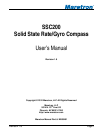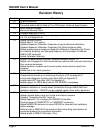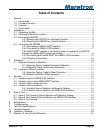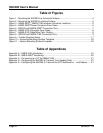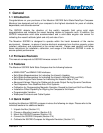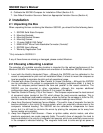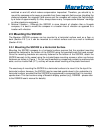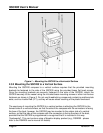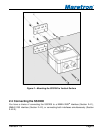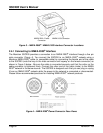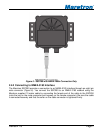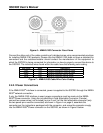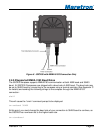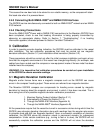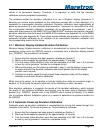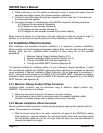
SSC200 User’s Manual
Page 2 Revision 1.8
6. Calibrate the SSC200 Compass for Installation-Offset (Section 3.2)
7. Use Default Variation Source or Select an Appropriate Variation Source (Section 4)
2 Installation
2.1 Unpacking the Box
When unpacking the box containing the Maretron SSC200, you should find the following items.
• 1 - SSC200 Solid State Compass
• 2 - Mounting Brackets
• 4 - Mounting Bracket Screws
• 4 - Mounting Screws
• 1 - 10 meter NMEA 0183 Cable*
• 1 - NMEA 2000
®
Micro Field Attachable Connector (Female)*
• 1 - SSC200 User’s Manual
• 1 - Warranty Registration Card
* Only included in SSC200-01
If any of these items are missing or damaged, please contact Maretron.
2.2 Choosing a Mounting Location
The selection of a suitable mounting location is important for the optimal performance of the
Maretron SSC200. The mounting location and orientation of the Maretron SSC200 should be:
1. Level with the Earth’s Horizontal Plane – Although the SSC200 can be calibrated in the
vessel to compensate for pitch and roll installation-offset, it is best to mount the compass as
level as possible to maximize its pitch and roll operational range.
2. Oriented with Arrow Pointing to Bow Parallel to Vessel Centerline – Although the SSC200
can be calibrated in the vessel to compensate for heading installation-offset, it is best to
mount the compass pointed towards the bow and parallel to the vessel centerline. The
SSC200 can be mounted in other orientations, although this requires additional
configuration steps; please refer to Section 2.3 on page 3 for details.
3. Near the Center of Gravity (CG) of the Vessel – The compass experiences the least amount
of movement when located at the CG, which allows the most accurate readings. This is
similar to a traditional card/needle compass, where the farther the compass is from the CG,
then the more the fluid sloshes around, making accurate readings more difficult.
4. Away from Structures Containing Ferrous Metals – The earth’s lines of magnetic flux tend to
become distorted in the vicinity of ferrous metals, which can potentially cause errors in the
compass’s indicated heading. The SSC200 can be calibrated to compensate for these
errors, but it is still best to minimize the errors by placing the compass as far away from
ferrous metals as is practical.
5. Away from Magnetic Field Sources – Power or ignition cables, electric motors, and other
electronic equipment can create magnetic fields. The earth’s lines of magnetic flux tend to
become distorted in the vicinity of magnetic field sources, which can potentially cause errors
in the compass’s indicated heading. The magnetic fields tend to come and go as power is



